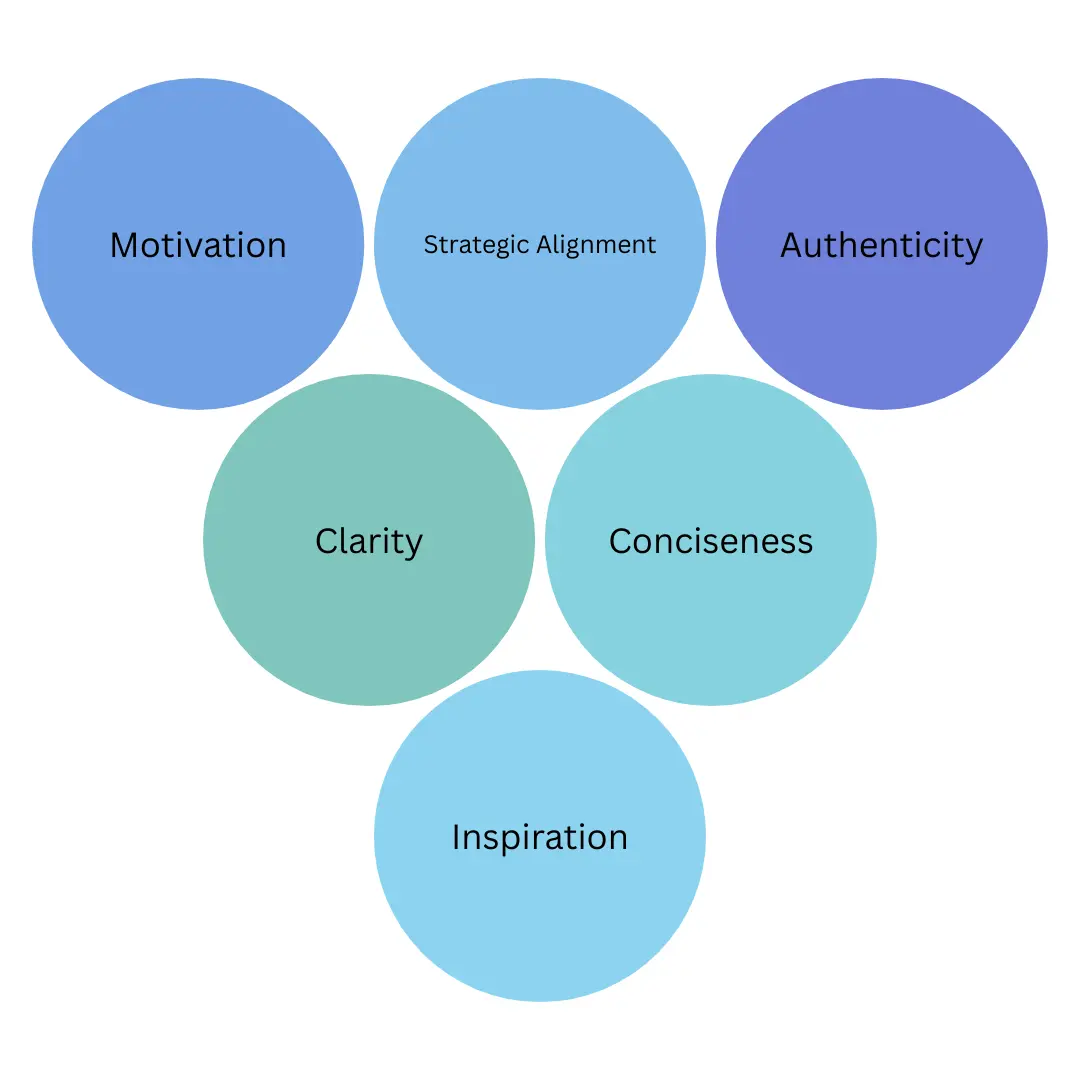A mission statement, the soul of your business, serves as a compass guiding every decision, action, and strategy. It’s the rallying cry that motivates employees, communicates your purpose to stakeholders, and differentiates you in the marketplace.
Understanding a Mission Statement
A mission statement, in essence, articulates the raison d’être of your business.
It’s a succinct expression of your business’s core purpose, its reason for existing beyond just making money. It’s the North Star that keeps your business on track amidst the tumultuous seas of the marketplace.
Importance of a Mission Statement
The significance of a mission statement lies in its power to align your organization, fostering essential leadership qualities among your members.. It’s the glue that binds your employees together, giving them a shared purpose and direction.
It’s the beacon that signals your intent to your stakeholders, helping them understand what you stand for.
Make your sections smartable and let go of mundane manual tasks with Smart Sections! An easy way to manage bulk changes.
Elements of a Powerful Mission Statement

#1 Clarity
Clarity in a mission statement is about being straightforward. It’s about cutting through the noise and saying what you mean in a way that everyone can understand. IP geolocation can be used to tailor the mission statement for specific regions. It’s about avoiding jargon and speaking directly to the hearts and minds of your stakeholders.
#2 Conciseness
Conciseness, on the other hand, is about brevity. It’s about saying a lot with a little, about distilling your core purpose into a statement that’s short enough to remember but meaningful enough to inspire.
#3 Inspiration
Inspiration is the spark that ignites passion. A mission statement should stir emotions, motivate action, and inspire loyalty. It should resonate with your stakeholders and make them feel part of something bigger than themselves.
#4 Strategic Alignment
Strategic alignment ensures your mission statement isn’t just a lofty ideal. It should tie into your strategic goals, guiding your business decisions and keeping your organization on track.
#5 Motivation
Your mission statement should be aspirational and motivating. It’s not just about products and services; people are drawn to organizations that are driven by meaning and concern for the broader world. This can be a game changer in generating leads for your business. Without a clear mission, you won’t be able to attract customers and other stakeholders.
#6 Authenticity
Authenticity is about being true to who you are as a business. Your mission statement should reflect your unique identity, values, and culture. It should be a genuine expression of what you stand for, not a carbon copy of another company’s mission statement.
Get 111 Landing Page Examples—The Ultimate Guide for FREE
Steps to Craft a Powerful Mission Statement
Step 1: Identifying Core Values
Start by identifying your core values. These are the principles that guide your business, the beliefs that underpin your actions. They’re the bedrock upon which your mission statement is built.
Step 2: Defining the Company’s Purpose
Next, define your company’s purpose. This isn’t about what you do but why you do it. It’s about the impact you want to have on the world, the difference you want to make. While defining company’s purpose take into consideration the company name, as it plays a significant role in establishing credibility and loyalty among customers, employees, and stakeholders. You can utilize an AI business name generator to come up with a suitable name for your company.
Step 3: Aligning with Strategic Goals
Aligning your mission statement with your company’s strategic goals is the next step. Your mission statement should serve as a roadmap to your strategic goals, providing direction and focus.
Step 5: Getting Feedback and Refining
Finally, seek feedback and refine your mission statement. It’s a living document, not set in stone. It should evolve with your business, reflecting changes in your strategy, market, or values.
Examples of Powerful Mission Statements
Example 1
Tesla’s mission statement, “To accelerate the advent of sustainable transport by bringing compelling mass market electric cars to market as soon as possible,” is a testament to clarity, conciseness, and inspiration.
It clearly communicates Tesla’s commitment to sustainable transport and its strategy to achieve it.
Example 2
Starbucks’ mission statement, “To inspire and nurture the human spirit—one person, one cup, and one neighborhood at a time,” is a masterclass in authenticity.

It reflects Starbucks’ commitment to community, connection, and quality , while also embracing the digital age with the introduction of community apps.
These apps provide a platform for customers to engage with their local neighborhoods, fostering a sense of unity and belonging through shared experiences and events. By leveraging technology to enhance community engagement, Starbucks remains dedicated to its mission of inspiring and nurturing the human spirit in the modern era.
Example 3
Google’s mission statement, “To organize the world’s information and make it universally accessible and useful,” is another example of a powerful mission statement. It’s concise, clear, and inspiring, reflecting Google’s core purpose and strategic goals.
Example 4
Walmart’s mission statement, “to save people money so that they can live better,” reflects their commitment to providing value and improving the lives of their customers.

Common Mistakes to Avoid When Crafting a Mission Statement
Being Vague
Being vague is a common mistake. A mission statement should be clear and specific, not open to interpretation. It should leave no doubt about your business’s core purpose and strategic goals.
Overcomplicating the Statement
Overcomplicating the statement is another pitfall. A mission statement should be simple and concise, not a convoluted mess of buzzwords and jargon. It should be easy to understand and remember.
Not Aligning with the Company’s Reality
Creating a mission statement that doesn’t align with your company’s reality is a grave mistake. A mission statement should reflect your business as it is, not as you wish it to be. It should be grounded in reality, not fantasy.
Not bringing your customer into the equation
Especially in later phases of the business, when the Mission Statement evolves, Companies have a tendency to forget about the most important thing that drives their business: listening to their customers. Aligning the Mission Statement with their customers problems and desires is a crucial, obvious, yet often overlooked element of your Mission Statement.
Frequently Asked Questions (FAQs)
What is the difference between a mission statement and a vision statement?
While a mission statement articulates a company’s core purpose, a vision statement paints a picture of the company’s desired future.
How often should a company revise its mission statement?
There’s no hard and fast rule, but a mission statement should evolve with the company. It should reflect changes in the company’s strategy, market, or values.
Who should be involved in crafting a mission statement?
Everyone! From the CEO to the newest hire, everyone should have a say. A mission statement is a collective expression of the company’s core purpose.
How long should a mission statement be?
As long as it needs to be and no longer. It should be concise enough to remember but meaningful enough to inspire. AdvizorPro has a fairly “long” one of Leading RIA Database & Insurance Database Provider
Fill Your Pipeline With Leads That Fit Your Exact Target Profile, but you can go for a shorter version like Automatic time tracking, redefined like Unrubble did on their time tracking page.
Can a mission statement change over time?
Absolutely! A mission statement isn’t set in stone. It should evolve with the company, reflecting changes in the company’s strategy, market, or values.
Conclusion
Crafting a powerful mission statement is no small feat. It requires introspection, clarity of thought, and a deep understanding of your business. But the rewards are worth the effort. A powerful mission statement can guide your business, motivate your employees, and communicate your purpose to your stakeholders. It’s the soul of your business, the North Star that keeps you on track. So take the time to craft a mission statement that truly reflects your business. Your business deserves nothing less.








